

ToPhonetics. Convert IPA phonetic notation text to speech. How does it work?
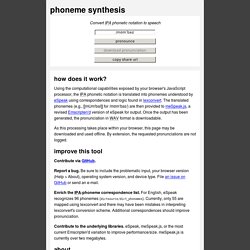
Using the computational capabilities exposed by your browser's JavaScript processor, the IPA phonetic notation is translated into phonemes understood by eSpeak using correspondences and logic found in lexconvert. The translated phonemes (e.g., [[mUm'baI]] for /mʊmˈbaɪ/) are then provided to meSpeak.js, a revised Emscripten'd version of eSpeak for output. Volume 3 (2018): Issue 4 (Nov 2018): Special Issue: Facing the World: Towards a Global History of Non-Latin Type Design, edited by Thomas S. Mullaney.
Erik Kwakkel blogging about medieval manuscripts. Turning Over a New Leaf. Ludovico buti uffizi ceiling. Inicio Biblioteca Digital Mundial. Resultados de búsqueda. Early English Books Online - EEBO. La caligrafía española en el siglo XIX- II parte. Mirando las tendencias de principios del siglo XIX ya vemos que poco a poco la influencia de la letra inglesa acabará por introducirse como práctica habitual de los calígrafos en especial a partir ya de 1840 donde la mayoría de tratados la divulgan al mismo nivel que los modelos clásicos españoles.
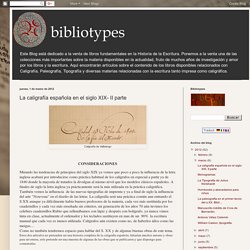
A finales de siglo la letra inglesa ya prácticamente será la más utilizada en la práctica caligráfica. También vemos la influencia de las nuevas tipografías de imprenta y ya a final de siglo la influencia del arte "Nouveau" en el diseño de las letras. Como no también tendremos espacio para hablar del S. XX y de algunas buenas obras de este tema.Estos dos artículos no pretenden ser una historia completa de la caligrafía española, faltarían muchos autores y obras para ser entera, solo pretende ser una muestra de algunas de las obras que se publicaron.y que dispongo para comentarlas. W. "EL PENDOLISTA UNIVERSAL. Nueva York: Imp. Jorge W. Muestra se rasgueos y pendolismo: Pipino el Breve. Robert Pfeffers Seiten. The Self-Taught Philosopher: How a 900-year-old Arabic tale inspired the Enlightenment - Home. Tuesday May 16, 2017 Our contemporary values and ideals are generally seen as the product of the Enlightenment.

Individual rights, independent thinking, empiricism and rationalism are traced to the debates and discussions held by the great European thinkers of the 17th and 18th century: Locke, Rousseau, Voltaire, and Kant among others. Evolution of the Medieval Book. Introduction Among the many innovations that transformed Europe in the Middle Ages, perhaps none was more central than the metamorphosis of the written word.
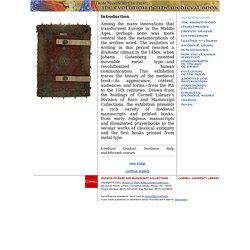
The evolution of writing in this period reached a dramatic climax in the 1450s, when Johann Gutenberg invented moveable metal type—and revolutionized human communication. This exhibition traces the history of the medieval book—its appearance, content, audiences, and forms—from the 9th to the 15th centuries. Drawn from the holdings of Cornell Library’s Division of Rare and Manuscript Collections, the exhibition presents a rich variety of medieval manuscripts and printed books, from early religious manuscripts and illuminated prayerbooks to the secular works of classical antiquity and the first books printed from metal type. The Palaeography of Gothic Manuscript Books: From the Twelfth to the Early ... - Albert Derolez. Medievalbooks. What a clever device the book is.
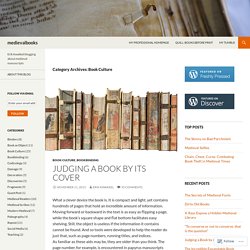
It is compact and light, yet contains hundreds of pages that hold an incredible amount of information. Moving forward or backward in the text is as easy as flipping a page, while the book’s square shape and flat bottom facilitates easy shelving. Still, the object is useless if the information it contains cannot be found. And so tools were developed to help the reader do just that, such as page numbers, running titles, and indices. Comité international de paléographie latine. Books before print. Corpus Christi College Oxford - Special Lectures. F W Bateson Memorial Lectures The F W Bateson Memorial Lecture was founded by the pupils and friends of F W Bateson (1901-1978).
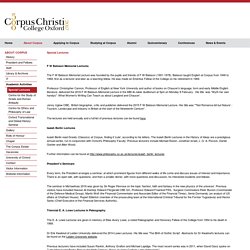
Bateson taught English at Corpus from 1946 to 1969, first as a lecturer and later as a teaching fellow. He was made an Emeritus Fellow of the College on his retirement in 1969. Professor Christopher Cannon, Professor of English at New York University and author of books on Chaucer's language, form and early Middle English literature, delivered the 2016 F W Bateson Memorial Lecture in the MBI Al Jaber Auditorium at 5pm on Monday 8 February. Khanacademy. Erik Kwakkel, ‘Ouderdom en genese van de veertiende-eeuwse Hadewijch-handschriften’ Erik Kwakkel. InScribe: palaeography learning materials. Media - De Kennis van nu Nieuws. De Nederlandse Publieke Omroep maakt gebruik van cookies.

We maken een onderscheid tussen functionele cookies en cookies voor het beheer van webstatistieken, advertenties en social media. Media - Hoe onderzoek je een boek zonder het te lezen? Erik Kwakkel is geen alledaagse wetenschapper.

Als een echte Sherlock Holmes bestudeert hij middeleeuwse boeken van top tot teen, behalve... door ze te lezen. En toch komt de historicus via zijn methode enorm veel over die boeken te weten. Book historian documents bored scribes' scribbles in 1,000-year-old Medieval manuscripts - Home. Before Gutenberg invented the printing press, the book business could be a form of torture.

Imagine copying out page after page of Fifty Shades of Grey with a quill pen, all day, every day, for the rest of your life. Considering that existence, it's not surprising that Medieval scribes let their attention and pens wander from time to time out of boredom. "I encountered [scribe doodles] almost every day as I read Medieval books," Professor Erik Kwakkel, a book historian at Leiden University in Holland, tells As It Happens host Carol Off. How to make sense of the credits at the end of a... X-rays reveal 1,300-year-old writings inside later bookbindings. Medieval doodles prove that it's goode to scribble in ye margins. Meet the Man Who Catalogs Medieval Cartoons - Modern Notion. Just take a cursory look at the art from medieval times and you’ll be as convinced as I that people living through the Middle Ages were somewhat humorless.
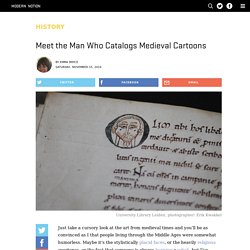
Maybe it’s the stylistically placid faces, or the heavily religious overtones, or the fact that someone is always burning a witch, but I’ve often felt that medieval folks really just didn’t get the joke. And yet Erik Kwakkel, a medieval book historian from Leiden University in the Netherlands, sees something more. He seeks out medieval cartoons; signs of humor and personality in ancient stately manuscripts.
Medieval History, Illuminated: Book Historian Erik Kwakkel Uncovers the Past Through Books. Damaged binding in Leiden University Library shows hidden fragment. Photo by Erik Kwakkel. At Medieval Books, book historian Erik Kwakkel brings the world of medieval manuscripts to life. Erik is a lecturer at Leiden University, the oldest university in the Netherlands, and blogs about this specialized topic in fresh ways.